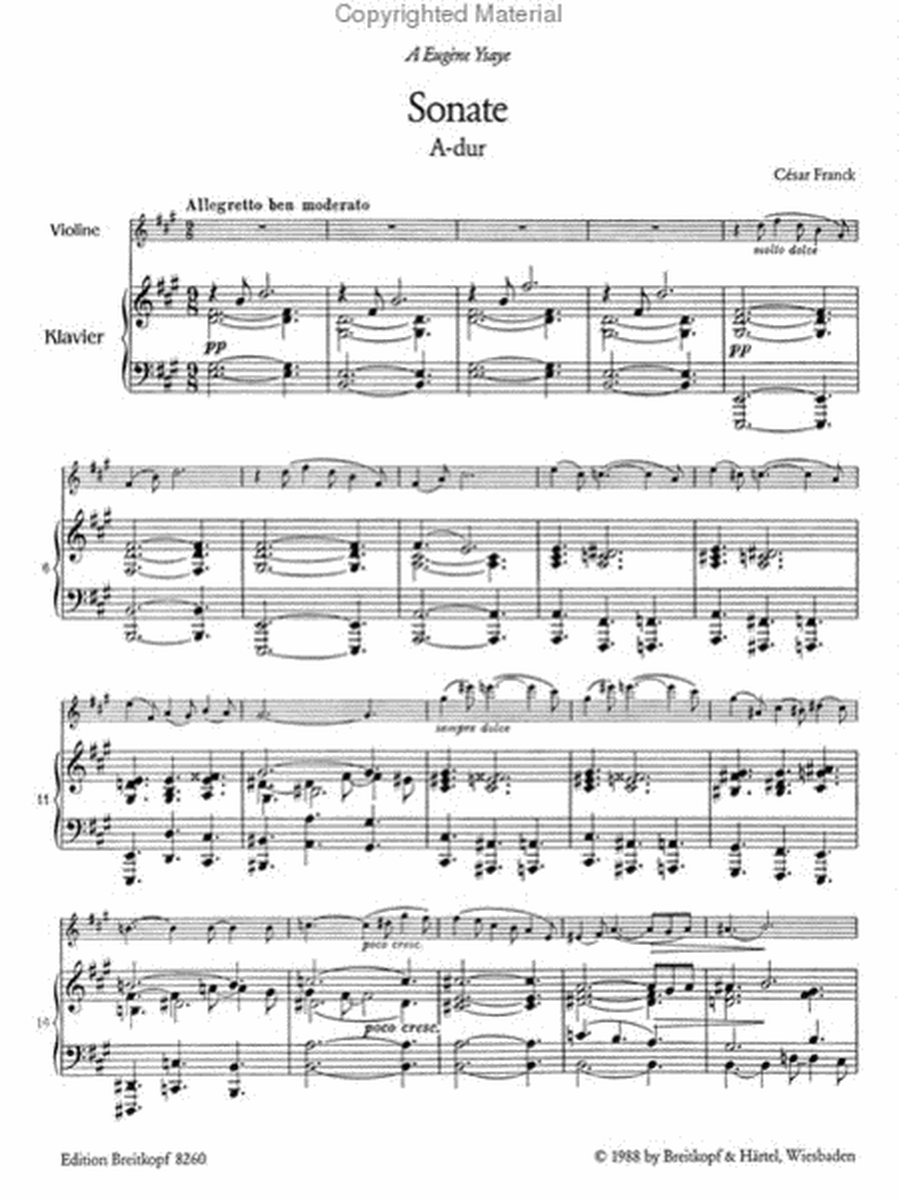
Happy Present Meet
Franck Sonata in A Major for Flute and Piano
Cesar Franck (1822-1890) exercised an unusually strong influence on the French music of his time and on that of following generations, both as a composer and teacher. He generated stylistically formative Impulses by focussing on absolute instrumental music, by integrating contrapuntal compositional techniques into the Romantic musical idiom, and by displaying a tendency to base his works, even those in sonata or symphonic form, on one single theme. Also typical of Franck's major works are bold chromatic modulations within extremely narrow limits - which purportedly prompted Debussy to call Franck a "modulation machine". Only few of Cesar Franck's numerous works have found a firm footing in todays concert repertoire, although his oeuvre includes a number of pieces for piano and organ, symphonic poems, several oratorios, two operas, songs and chamber music. But although few in number, his regularly performed works are very popular: the D-minor Symphony, the "Variations symphoniques" for piano and orchestra, several organ and piano works and the A-major Sonata for violin and piano.
This work was written in 1886 and dedicated to the Belgian violinist Eugene Ysaye (1858-1931). It soon became a standard repertoire piece of all violin virtuosos. The first transcription - a version for violoncello and piano - was apparently even published during the composer's lifetime. Although Franck's approval of this arrangement has only been passed on by word of mouth, cellists are only too eager to believe the truth of this allegation. Flutists too can also lay claim to a relatively early version for their Instrument. Of course it is a moot point whether such arrangements of successful pieces for different solo instruments actually concur with the composer's intentions. The performer must appeal to his own judgement in determining the legitimacy of the arrangement, whereby he should always ask himself whether the newly won "color" of the transcription justifies the loss of the original sound conception. In our particular case, the flutist must also ask himself whether he is able to meet the expressive demands required from the violin. In view of the ever greater proficiency of flutists, this criterion will undoubtedly acquire more and more importance. The score of this new edition was revised on the basis of Cesar Francks autograph (in the Pierpont Morgan Library, New York). The tempo, articulation and dynamic markings were reproduced as faithfully as possible. Missing accidentals were tacitly added, and editorial indications placed in brackets.
The emendations made by the editor have not been pointed out in the separate solo part. However, they can be easily identified by comparing the part with the score. We would like to draw attention to the original articulation in the second movement, bars 34ffff and 158ff., which is ignored by the majority of perfonners (even by Adolf Busch). The non-legato and the phrase endings with short eighth notes (instead of quarter notes) represent a fundamental musical variant, which is all the more valuable when considering that the flutist has already had to forgo the lower octave at the first entrance.
Basel, Spring 1988
세자르 프랑크(1822-1890)는 작곡가이자 교사로서 당시의 프랑스 음악과 그 이후 세대의 프랑스 음악에 비정상적으로 강한 영향을 미쳤습니다. 그는 절대적인 기악 음악에 집중하고, 대위법적 작곡 기법을 낭만주의 음악적 관용어에 통합하고, 소나타나 교향곡 형식의 작품조차도 하나의 주제를 기반으로 하는 경향을 보임으로써 스타일적으로 형성된 충동을 생성했습니다. 또한 프랑크의 주요 작품에서 전형적인 것은 극히 좁은 범위 내에서 대담한 색채 변조입니다. 이는 드뷔시가 프랑크를 "변조 기계"라고 부르게 된 계기가 되었다고 합니다. 세자르 프랑크의 수많은 작품 중 오늘날의 콘서트 레퍼토리에서 확고한 입지를 굳힌 작품은 몇 개뿐이지만, 그의 작품에는 피아노와 오르간을 위한 여러 작품, 교향시, 여러 오라토리오, 두 개의 오페라, 가곡, 실내악이 포함됩니다. 하지만 그 수는 적지만, 정기적으로 연주되는 그의 작품은 매우 인기가 있습니다. D단조 교향곡, 피아노와 오케스트라를 위한 "Variations symphoniques", 여러 오르간과 피아노 작품, 바이올린과 피아노를 위한 A장조 소나타가 있습니다.
이 작품은 1886년에 작곡되어 벨기에 바이올리니스트 외젠 이자이(1858-1931)에게 헌정되었습니다. 곧 모든 바이올린 거장의 표준 레퍼토리가 되었습니다. 첼로와 피아노를 위한 버전인 첫 번째 편곡은 작곡가의 생전에 출판된 것으로 보입니다. 프랑크가 이 편곡을 승인했다는 소식은 입소문을 통해서만 전해졌지만, 첼리스트들은 이 주장이 사실이라고 믿고 싶어합니다. 플루티스트들도 자신의 악기에 대한 비교적 초기 버전을 주장할 수 있습니다. 물론, 다양한 독주 악기를 위한 성공적인 작품의 편곡이 실제로 작곡가의 의도와 일치하는지는 논쟁의 여지가 있습니다. 연주자는 편곡의 합법성을 판단할 때 자신의 판단에 호소해야 하며, 항상 전사본의 새로 얻은 "색깔"이 원래의 사운드 개념의 상실을 정당화하는지 스스로에게 물어봐야 합니다. 우리의 특별한 경우, 플루티스트는 또한 바이올린에 필요한 표현적 요구 사항을 충족할 수 있는지 스스로에게 물어봐야 합니다. 플루티스트의 능력이 점점 더 향상됨에 따라 이 기준은 의심할 여지 없이 점점 더 중요해질 것입니다. 이 새로운 판의 악보는 세자르 프랑크의 사인본(뉴욕 피에르폰트 모건 도서관)을 기반으로 수정되었습니다. 템포, 아티큘레이션 및 다이내믹 표시는 가능한 한 충실하게 재현되었습니다. 누락된 우연음은 암묵적으로 추가되었고 편집 표시는 괄호 안에 넣었습니다.
편집자가 수정한 내용은 별도의 솔로 부분에서 지적되지 않았습니다. 그러나 악보와 부분을 비교하면 쉽게 식별할 수 있습니다. 우리는 2악장, 34ffff와 158ff.마디의 원래 아티큘레이션에 주의를 기울이고 싶습니다. 이는 대부분의 연주자(아돌프 부쉬도 마찬가지)가 무시합니다. 논레가토와 짧은 8분음표(4분음표 대신)로 끝나는 프레이즈는 근본적인 음악적 변형을 나타내며, 플루티스트가 이미 첫 번째 입장 시 낮은 옥타브를 포기해야 했다는 점을 고려할 때 더욱 가치가 있습니다.
바젤, 1988년 봄
편곡자 Graf, Peter-Lukas
작곡가 Franck, Cesar (1822-1890)

Saint-Saens Introduction and Rondo Capriccioso Op.28 arr. for Flute and Piano
Schocker 3 Dances for 2 Flutes and Piano
Muczynski Moments Op.47 for Flute and Piano
Schumann Symphony No.2 Op.61 (Miniature Score)
[특가상품] Boehm 24 Caprices Op.26 for Flute Solo
Taffanel and Gaubert 17 Big Daily Finger Exercises for Flute Solo
Faure Berceuse Op.16 for Flute (or Oboe, Clarinet) and Piano
Debussy Clair de Lune for Flute and Piano
Faure Sicilienne Op.78 for Flute and Piano
Mendelssohn A Midsummer Night`s Dream Op.61 (Miniature Score)